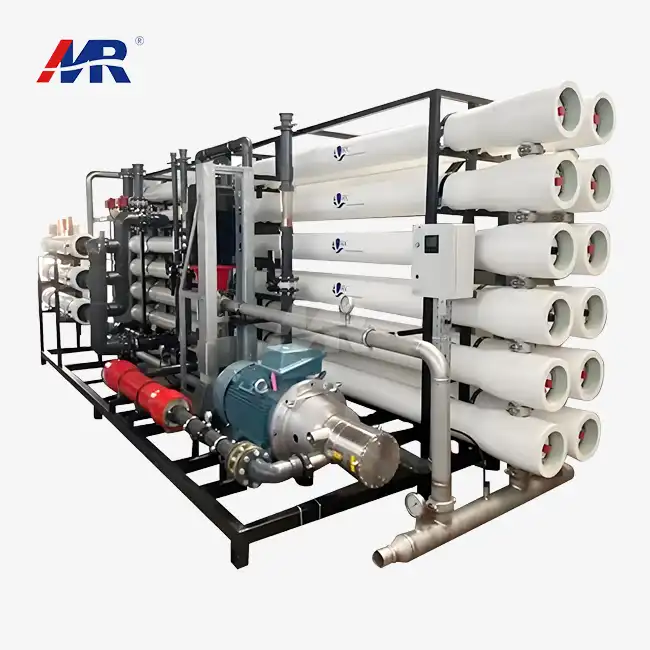Common Causes of RO Membrane Fouling & Scaling
Understanding the primary culprits behind membrane fouling is essential for developing effective prevention strategies. In SWRO plants, several factors contribute to the degradation of membrane performance:
- Particulate Fouling: Suspended solids, such as silt, clay, and organic matter, can accumulate on the membrane surface, forming a cake-like layer that impedes water flow. This type of fouling is particularly prevalent in areas with high turbidity or during algal blooms.
- Biological Fouling (Biofouling): Microorganisms present in seawater, including bacteria, algae, and fungi, can adhere to membrane surfaces and form biofilms. These living colonies not only restrict water passage but also secrete substances that can damage the membrane structure.
- Scaling: The precipitation of sparingly soluble salts, such as calcium carbonate, calcium sulfate, and silica, can form hard, crystalline deposits on membrane surfaces. Scaling is often exacerbated by changes in pH, temperature, and concentration factors within the RO system.
- Organic Fouling: Natural organic matter (NOM), including humic and fulvic acids, can adsorb onto membrane surfaces, creating a gel-like layer that reduces permeability. This type of fouling is particularly challenging to remove and can act as a nutrient source for biofouling.
Chemical Cleaning vs. Antiscalants: Fouling Solutions
When it comes to combating membrane fouling in seawater desalination systems, operators have two primary approaches at their disposal: chemical cleaning and the use of antiscalants. Each method has its advantages and applications, and often a combination of both is employed for optimal results.
Chemical Cleaning Protocols
Chemical cleaning is a reactive measure used to remove existing foulants from membrane surfaces. The process typically involves the following steps:
- System shutdown and draining
- Circulation of cleaning chemicals through the membrane elements
- Soaking period to allow chemical reactions to occur
- Flushing and rinsing to remove loosened foulants and residual chemicals
- Final system restart and performance evaluation
Cleaning chemicals are selected based on the type of fouling encountered. For example, acidic solutions are effective against inorganic scaling, while alkaline cleaners target organic fouling and biofouling. Oxidizing agents may be used for severe biological contamination.
Antiscalant Application
Antiscalants, on the other hand, are preventive measures designed to inhibit the formation of scale and other foulants. These specialized chemicals work by:
- Interfering with crystal growth and precipitation of scaling compounds
- Modifying the structure of scale deposits to make them less adherent
- Dispersing particles to prevent agglomeration on membrane surfaces
Modern antiscalants are formulated to be effective against a wide range of potential foulants, including calcium carbonate, calcium sulfate, barium sulfate, and silica. They are typically dosed continuously into the feed water stream, providing ongoing protection against scaling and fouling.
Integrated Approach
While chemical cleaning and antiscalant use are powerful tools in the fight against membrane fouling, they are most effective when used as part of a comprehensive fouling management strategy. This integrated approach may include:
- Regular monitoring of feed water quality and system performance
- Optimization of operating conditions to minimize fouling potential
- Implementation of advanced pre-treatment methods
- Scheduled maintenance and cleaning procedures
- Use of membrane-compatible antiscalants and cleaning chemicals
By combining these strategies, operators can significantly extend membrane life, reduce energy consumption, and maintain high water quality output in their seawater desalination plants.
Advanced Pre-treatment Methods to Reduce Fouling
As the desalination industry continues to evolve, advanced pre-treatment technologies have emerged as crucial components in the battle against membrane fouling. These innovative methods aim to remove potential foulants before they reach the RO membranes, thereby reducing the frequency of chemical cleanings and extending overall system lifespan.
Ultrafiltration (UF) Pre-treatment
Ultrafiltration has gained widespread acceptance as a highly effective pre-treatment option for seawater desalination systems. UF membranes can remove particles, colloids, and even some dissolved organic matter, significantly reducing the fouling potential of the feed water. Benefits of UF pre-treatment include:
- Consistent removal of particles down to 0.01 microns in size
- Reduction in silt density index (SDI) to levels below 3
- Improved removal of bacteria and viruses
- Stable performance under varying feed water conditions
Dissolved Air Flotation (DAF)
DAF is particularly effective in removing algae, oil, and grease from seawater. The process involves introducing fine air bubbles into the water, which attach to suspended particles and cause them to float to the surface for easy removal. When combined with conventional media filtration or UF, DAF can significantly reduce organic and particulate fouling in RO systems.
Advanced Oxidation Processes (AOPs)
AOPs, such as ozonation or UV/hydrogen peroxide treatment, can be employed to break down complex organic compounds and inactivate microorganisms. These processes generate highly reactive hydroxyl radicals that oxidize organic matter, making it more biodegradable and easier to remove through subsequent filtration steps.
Ion Exchange Softening
In cases where scaling is a primary concern, ion exchange softening can be used to remove hardness ions (calcium and magnesium) from the feed water. This process replaces these scaling-prone ions with sodium, effectively reducing the scaling potential in the RO system.
Micro-Electrolysis
This emerging technology uses a combination of electrocoagulation and electroflotation to remove a wide range of contaminants from seawater. Micro-electrolysis can effectively reduce turbidity, organic matter, and dissolved metals, providing a comprehensive pre-treatment solution for challenging feed water conditions.
By implementing these advanced pre-treatment methods, operators of seawater desalination plants can significantly reduce the fouling potential of their feed water, leading to more stable and efficient RO system performance. The choice of pre-treatment technology should be based on a thorough analysis of feed water quality, system requirements, and economic considerations.
Conclusion
Membrane fouling prevention is a critical aspect of maintaining efficient and cost-effective seawater desalination operations. By understanding the common causes of fouling, implementing appropriate chemical cleaning and antiscalant strategies, and utilizing advanced pre-treatment methods, plant operators can significantly extend membrane life, reduce energy consumption, and ensure consistent high-quality water production.
Are you looking to optimize your seawater desalination system or implement cutting-edge fouling prevention strategies? Guangdong Morui Environmental Technology Co., Ltd. is your trusted partner in water treatment solutions. Our state-of-the-art 60m³/hour reverse osmosis plants are designed to meet the diverse needs of industries ranging from municipal water treatment to manufacturing and beyond.
With our extensive experience in industrial wastewater treatment, domestic sewage management, and drinking water production, we offer comprehensive solutions tailored to your specific requirements. Our team of expert engineers and technicians provides one-stop installation, commissioning, and after-sales services, ensuring worry-free operation of your desalination equipment.
Take advantage of our in-house membrane production capabilities and partnerships with leading brands in water treatment technology. Contact us today at benson@guangdongmorui.com to discover how we can help you achieve optimal performance and longevity in your seawater desalination operations.
References
1. Voutchkov, N. (2021). Membrane Fouling and Scaling in Seawater Reverse Osmosis Desalination. IDA Journal of Desalination and Water Reuse, 13(1), 1-15.
2. Jiang, S., Li, Y., & Ladewig, B. P. (2017). A review of reverse osmosis membrane fouling and control strategies. Science of the Total Environment, 595, 567-583.
3. Ghaffour, N., Missimer, T. M., & Amy, G. L. (2013). Technical review and evaluation of the economics of water desalination: Current and future challenges for better water supply sustainability. Desalination, 309, 197-207.
4. Prihasto, N., Liu, Q. F., & Kim, S. H. (2009). Pre-treatment strategies for seawater desalination by reverse osmosis system. Desalination, 249(1), 308-316.
5. Antony, A., Low, J. H., Gray, S., Childress, A. E., Le-Clech, P., & Leslie, G. (2011). Scale formation and control in high pressure membrane water treatment systems: A review. Journal of Membrane Science, 383(1-2), 1-16.
6. Greenlee, L. F., Lawler, D. F., Freeman, B. D., Marrot, B., & Moulin, P. (2009). Reverse osmosis desalination: Water sources, technology, and today's challenges. Water Research, 43(9), 2317-2348.

_1745823981883.webp)


